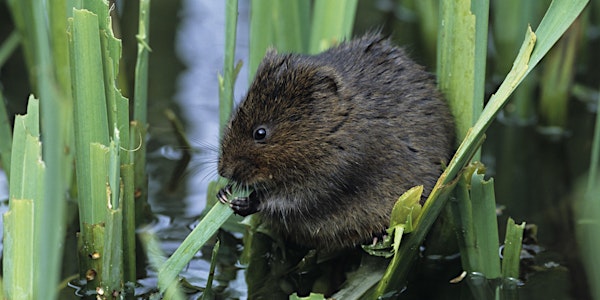

Water Voles and Otters - Ecology and Survey (online and field course)
Ecology, conservation and management of Water Voles and Otters - online (10th May) and half-day field session in Gloucestershire (13th May)
Date and time
Location
GL7 4JJ
Park Street Fairford GL7 4JJ United KingdomRefund Policy
About this event
- 3 days 7 hours
This course is aimed at anyone interested in surveying for water voles and otters, including for conservation and management purposes. The water vole has suffered a catastrophic decline over the last century, but populations are still found widely occurring across the UK, sometimes in unexpected habitats. The otter is now widespread across much of the UK and is regularly encountered in most wetland habitats. Both species are listed as priorities for conservation and are legally protected. It is therefore hugely important to be able to recognise the signs of both water voles and otters and understand their ecological requirements.
The course comprises a live online session followed by a half-day field session, focusing on:
- Water vole status, distribution and legal protection
- Water vole ecology and habitat requirements
- Water vole field signs
- Approaches to water vole survey
- Habitat management
- Otter status, distribution and legal protection
- Otter ecology and habitat requirements
- Otter field signs
- Approaches to otter survey
About the tutor
Mike Dean is one of the foremost experts on water voles in the UK, and author of the highly-regarded Water Vole Field Signs and Habitat Assessment guide and Water Vole Mitigation Handbook, which sets out current good practice guidance on surveying for water voles, assessing impacts and designing mitigation in the context of development projects. He was involved in the most recent national otter survey of England and is currently drafting guidance on otters for the Mammal Society. Mike has worked as an ecological consultant since 1997; running training courses since 2015.
Schedule
Friday10th May
- Live online session 9:30am - 3pm (invite link to be sent out closer to the time will likely take place on MS Teams)
Monday 13th May
- 3 -hour field session near Fairford, Gloucestershire - the group will split with half attendees joining a 9:30am-12:30pm morning field session and the remainder to a 1:15pm - 4:15pm afternoon field session. We will let you know which you will be attending closer to the time. You will have an opportunity to share your preference during the ticket purchase.
We will be visiting a river system that is used by both otters and water voles. To maximise our chances of finding evidence of both species we will need to visit multiple different locations along a main river and a tributary. The exact route will be determined on the day, but please note that access will be on foot, and could cover a distance of up to 5km. The route will be out-and-back along the main river, so there is an opportunity for some attending to wait at a (roughly) halfway point for others to return, and reduce the distance covered to approximately 3km.
In order to find signs of otters we may need to do some scrambling through areas of thorny scrub, so please wear suitable clothing. It is likely to be possible for some of the group to divert around these areas if they wish, but this may obviously restrict what they see during the visit.
What to bring
- Appropriate clothing
- Footwear – you should wear boots that are comfortable for walking the required distance. The tracks are muddy and there is the possibility of wading in shallow water. Wellies are ideal. Thigh waders may allow access to some areas that wellies won’t allow, but this is unlikely to be particularly beneficial, and they are likely to be extremely uncomfortable for walking a distance of 5km, so are not recommended. Chest waders are not recommended for the same reasons. Hiking boots may be OK, but please bring a spare pair of socks in case you get wet feet!
- A strong stick or wading pole for support when walking on steep banks of watercourses is recommended
- Binoculars
- Hand sanitiser / wipes
Please do let us know of any medical requirements/conditions we should be aware of prior to the course.
Directions
We will start on foot from Fairford Town Car Park, 1 Park Street, Fairford, Gloucestershire GL7 4JJ (free parking). Fairford is not easily accessible by public transport so you will need to use your own vehicle.
You will come into Fairford on the A417. Turn north up the High Street, through the centre of Fairford. The car park is at the top of the High Street, after the church – diagonally opposite you on the left hand side. Parking is available on the High Street but is time limited, so you should ignore those spaces and head for the car park.
what 3 words: ruin.mouths.koala
Google maps https://goo.gl/maps/CWZYqDBi1oNxWrac6
Biosecurity
Please make sure that clothing/footwear/equipment is appropriately dried/disinfected before the site visit. And please note that signal crayfish are present in the watercourse being visited, so you will need to dry/disinfect before visiting another site.
Course certificate
This course can be used as part of your Continuing Professional Development (CPD). We invite attendees to download their own certificate and complete the numbers of hours spent on the course, as we are aware some attendees spend more time reading up about courses before the day, and writing their notes up and sitting the online course tests afterwards. The hours on your certificate should accurately reflect this time.
Cover Image Water Vole (C) Simon Booth Photography
Cover Image Otter (C) Simon Pickering Photography
Organised by
A charity devoted to saving some of the UK's most endangered species